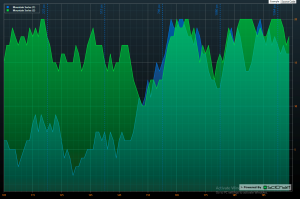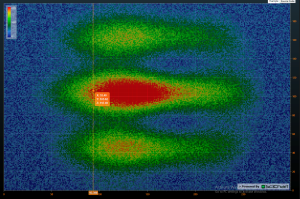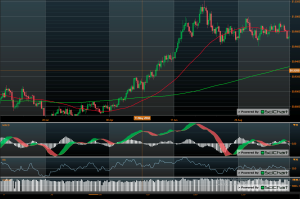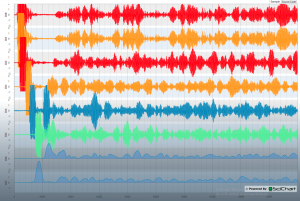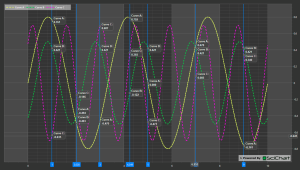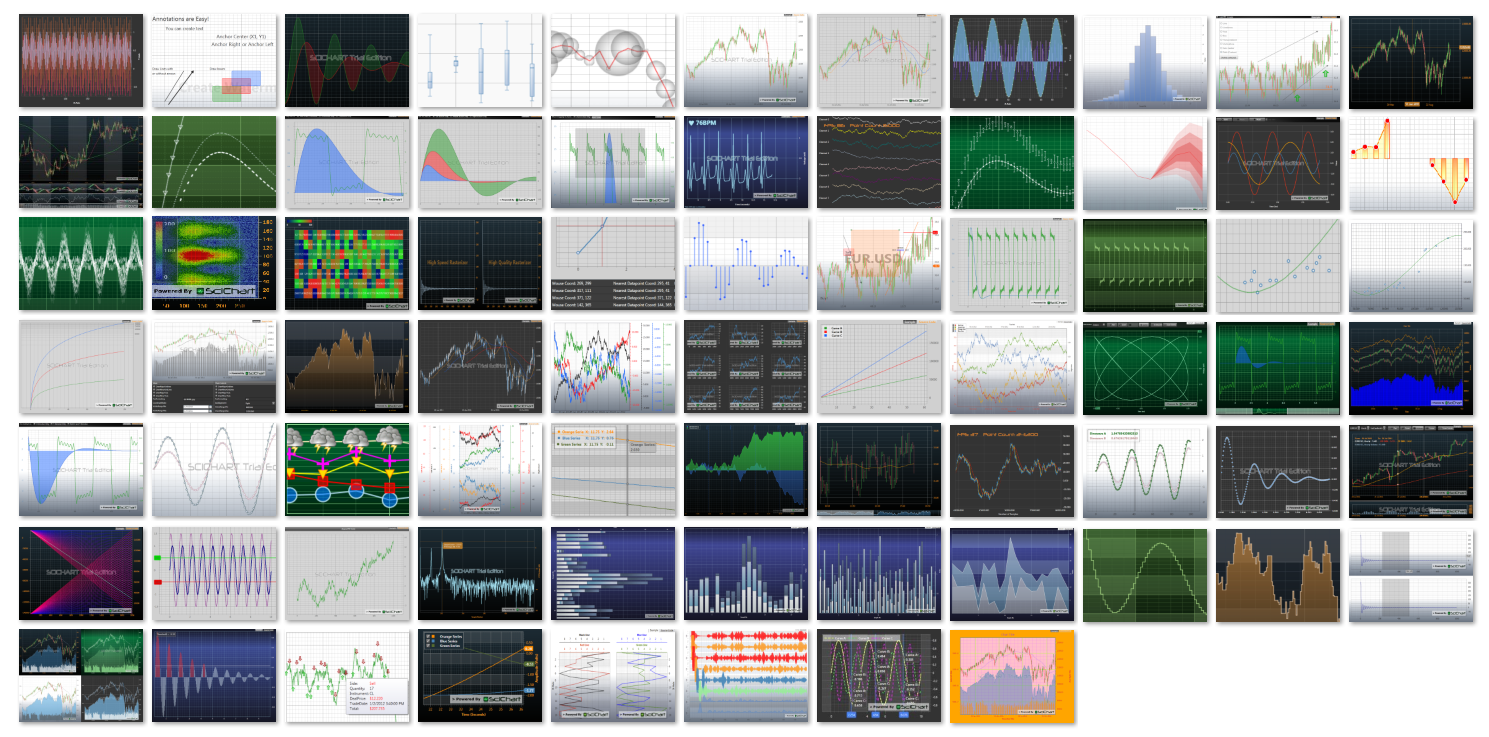
After what feels like a very long wait, SciChart v3.0 the release is finally here!! We’ve been through two intensive Beta cycles to bring you this and SciChart v3.0 is packed with new features, bug fixes and enhancements that will take your charting applications to the next level.
Some of you have asked why the wait, is something wrong? Well, we only like to release software that is of high quality, and not before its ready. We have many many users that we don’t want to disappoint. So, we’ve refined and refined again so that SciChart v3.0.2 is a product we are happy to put our names against, and there’s much more to come in minor updates too.
So, without further ado, here’s a run-down of the new features:
New Features & Improvements
1. ResamplingMode.MinMaxUneven
- Allows resampling of unevenly spaced data
- Previously SciChart required that data was evenly spaced in order to resample using ResamplingMode.MinMax and maintain accurate visual output.
- No more rendering errors when Resampling is used with unevenly spaced data
Usage:
[xml]
<SciChart:FastLineRenderableSeries ResamplingMode=”MinMaxWithUnevenSpacing”/>
[/xml]
2. ResamplingMode.Auto (Default)
- Auto-detection of data distribution (sorted, unsorted, evenly spaced, unevenly spaced)
- Best selection of fastest/most accurate resampling mode for your data.
- No more rendering errors due to MinMax resampling and data-distribution
Usage:
[xml]
<!– Note that ResamplingMode.Auto is the default setting –>
<SciChart:FastLineRenderableSeries ResamplingMode=”Auto”/>
[/xml]
3. UnsortedXyDataSeries is now Obsolete
- XyDataSeries now detects whether data is sorted or unsorted.
- No need to specify if data is unsorted, however performance is still better if it is.
- HitTest and resampling algorithms are changed accordingly.
4. MultiTouch support
- Zooming, panning, axis manipulations, cursors, annotation manipulations via touch screens in WPF and SL
Usage:
Multitouch is enabled by default in SciChart and all existing modifiers now have touch-support. To get a touch-specific pinch zoom action please use the PinchZoomModifier.
[xml]
<!– Adding the PinchZoomModifier gives SciChart the ability to zoom by pinching on a multi-touch screen –>
<sciChart:SciChartSurface.ChartModifier>
<sciChart:ModifierGroup>
<sciChart:PinchZoomModifier />
<sciChart:ZoomPanModifier />
<sciChart:ZoomExtentsModifier />
</sciChart:ModifierGroup>
</sciChart:SciChartSurface.ChartModifier>
[/xml]
5. Axis Styling improvements
- Chart Titles, Axis Titles and Labels can now be styled
- Can set font size, font style, font weight on Axis labels
- Now supports optional rotation of axis tick labels (e.g. 90 degrees)
Usage:
[xml]
<!– Styling Tick Labels with rotation and custom font-size and foreground –>
<s:DateTimeAxis>
<s:DateTimeAxis.TickLabelStyle>
<Style TargetType=”s:DefaultTickLabel”>
<Setter Property=”Foreground” Value=”Blue” />
<Setter Property=”FontSize” Value=”25″ />
<Setter Property=”LayoutTransform”>
<Setter.Value>
<RotateTransform Angle=”45″ />
</Setter.Value>
</Setter>
</Style>
</s:DateTimeAxis.TickLabelStyle>
</s:DateTimeAxis>
[/xml]
Or
[xml]
<!– Styling Numeric Axis Tick Labels –>
<s:NumericAxis>
<s:NumericAxis.TickLabelStyle>
<Style TargetType=”s:NumericTickLabel”>
<Setter Property=”Foreground” Value=”Blue” />
<Setter Property=”FontSize” Value=”25″ />
</Style>
</s:NumericAxis.TickLabelStyle>
</s:NumericAxis>
[/xml]
[xml]
<!– Declare an Axis Title Template –>
<Style x:Key=”BottomAxisTitleStyle” TargetType=”s:AxisTitle”>
<Setter Property=”ContentTemplate”>
<Setter.Value>
<DataTemplate>
<StackPanel>
<TextBlock Margin=”0,3,0,0″
Style=”{StaticResource TitleTextStyle}”
Text=”Showing time on”/>
<TextBlock HorizontalAlignment=”Center”
VerticalAlignment=”Center”
Text=”{Binding}” />
<TextBlock Margin=”0,0,0,3″
Style=”{StaticResource TitleTextStyle}”
Text=”(daily Timeframe)”/>
</StackPanel>
</DataTemplate>
</Setter.Value>
</Setter>
</Style>
<!– Apply an Axis Title Template –>
<s:DateTimeAxis AxisTitle=”Time Axis Title” TitleStyle=”{StaticResource BottomAxisTitleStyle}” Style=”{StaticResource AxisStyle}”/>
[/xml]
6. Axis Tick Algorithm Improvements
- AxisBase.TickProvider API to override in-built axis tick generation algorithms
- Improved axis culling / adjacency algorithm
Usage:
[csharp]
// Tickprovider Declaration
public class CustomTickProvider : TickProvider
{
public override DateTime[] GetMinorTicks(IAxisParams axis)
{
return new DateTime[] { new DateTime(2014, 1, 5), new DateTime(2014, 1, 15), new DateTime(2014, 1, 25) };
}
public override DateTime[] GetMajorTicks(IAxisParams axis)
{
return new DateTime[] { new DateTime(2014, 1, 1), new DateTime(2014, 1, 10), new DateTime(2014, 1, 20) };
}
}
// Using a TickProvider in code
var axis = new DateTimeAxis();
axis.TickProvider = new CustomTickProvider();
[/csharp]
OR
[xml]
<!– Where CustomTickProvider is declared as a Resource –>
<sciChart:DateTimeAxis TickProvider=”{StaticResource CustomTickProvider}”/>
[/xml]
7. Static Axis
- AxisBase.IsStaticAxis fixes all tick labels at static positions, and updates the text-values instead
- E.g. imagine a chart that always has 10 tick labels, as you zoom, scroll pan or update data, the tick positions do not change. Instead the tick values change.
- This is perfect for strip charts, oscilloscope style charts and monitors
[xml]
<!– Create Y Axis with IsStaticAxis flag –>
<sciChart:SciChartSurface.YAxes>
<sciChart:NumericAxis IsStaticAxis=”True” />
</sciChart:SciChartSurface.YAxes>
[/xml]
8. Axis VisibleRangeLimit
- Does not allow the axis to expand beyond the given AxisBase.VisibleRangeLimit.
- Provides a reset-point for double-click Zoom Extents, overriding the built-in auto-ranging mechanism
Usage:
[xml]
<!– Bind X and Y Axis VisibleRangeLimit to ViewModel properties –>
<s:SciChartSurface.XAxis>
<s:NumericAxis VisibleRangeLimit=”{Binding XLimit}”/>
</s:SciChartSurface.XAxis>
<s:SciChartSurface.YAxis>
<s:NumericAxis VisibleRangeLimit=”{Binding YLimit}”/>
</s:SciChartSurface.YAxis>
[/xml]
[csharp]
// Viewmodel properties declared as
private DoubleRange _xLimit;
public DoubleRange XLimit
{
get { return _xLimit; }
set
{
if (_xLimit == value) return;
_xLimit = value;
OnPropertyChanged(“XLimit”);
}
}
private DoubleRange _yLimit;
public DoubleRange YLimit
{
get { return _yLimit; }
set
{
if (_yLimit == value) return;
_yLimit = value;
OnPropertyChanged(“YLimit”);
}
}
[/csharp]
9. VisibleRangeChangedEventArgs.IsAnimating
- Allows to track VisibleRange changes during animation.
Usage:
[xml]
<!– Create an X Axis –>
<s:SciChartSurface.XAxis>
<s:NumericAxis VisibleRangeChanged=”OnXAxisVisibleRangeChanged”/>
</s:SciChartSurface.XAxis>
[/xml]
[csharp]// …
private void OnXAxisVisibleRangeChanged(object sender, VisibleRangeChangedEventArgs e)
{
if (e.IsAnimating)
{
// Handle animation changes here
// Note the event will fire once more after animating with e.IsAnimating is false
// so tracking the state of this property can give you information to exclude
// animation Visibility changes e.g. if you are tracking zoom history
}
}
[/csharp]
10. Xml Serialization Support
- Serialize Chart Settings to/from XML
- Serialize Annotation Positions to/from XML
Usage:
[csharp]
// Use this code to Serialize just annotations
private string SerializeAnnotations(AnnotationCollection annotationCollection)
{
var stream = new MemoryStream();
var serializer = new XmlSerializer(typeof (AnnotationCollection));
serializer.Serialize(stream, annotationCollection);
stream.Position = 0;
string xmlText = new StreamReader(stream).ReadToEnd();
return xmlText;
}
// Use this code to Deserialize just annotations
private AnnotationCollection DeserializeAnnotations(string xmlText)
{
var stream = new MemoryStream(Encoding.ASCII.GetBytes(xmlText));
var serializer = new XmlSerializer(typeof(AnnotationCollection));
stream.Position = 0;
var annotationCollection = (AnnotationCollection) serializer.Deserialize(stream);
return annotationCollection;
}
// Use this code to Serialize/Deserialize a SciChartSurface
private void SerializeChart()
{
var beforeChart = new SciChartSurface();
// …
var stream = new MemoryStream();
var serializer = new XmlSerializer(typeof(SciChartSurface));
serializer.Serialize(stream, beforeChart);
var afterChart = (SciChartSurface)serializer.Deserialize(stream);
}
[/csharp]
11. SciChartSurface.MaxFrameRate
- Limit frame-rate to a maximum Hertz, or leave null for default (unlimited).
- Useful for strip charts (eg. CPU, Temperature monitoring) in process control
- Note low values, e.g. 1, will not only limit redrawing but frame-rate when responding to mouse/zoom events
Usage:
[xml]
<SciChart:SciChartSurface MaxFrameRate=”24″>
[/xml]
12. Save Chart to Bitmap
- Export to BitmapSource, File built in to SciChartSurface.
- Supports file export to PNG, JPEG, BMP
Usage:
[csharp]var surface = new SciChartSurface();
//…
// Export to in-memory bitmap
var bitmapSource = surface.ExportToBitmapSource();
// Export directly to file
surface.ExportToFile(“Filename.png”,ExportType.Png);
[/csharp]
13. Heatmap Improvements
- Implemented HitTest for Heatmap, allowing RolloverModifier, Cursors.
- GradientBrush support for Heatmap colour maps
- New improved HeatmapColourMap control.
[xml]
<s:SciChartSurface.RenderableSeries>
<s:FastHeatMapRenderableSeries x:Name=”heatmapSeries”
Opacity=”0.5″
Maximum=”200″>
<!– Defining the Color Map using WPF LinearGradientBrush –>
<s:FastHeatMapRenderableSeries.ColorMap>
<LinearGradientBrush>
<GradientStop Offset=”0″ Color=”DarkBlue” />
<GradientStop Offset=”0.2″ Color=”CornflowerBlue” />
<GradientStop Offset=”0.4″ Color=”DarkGreen” />
<GradientStop Offset=”0.6″ Color=”Chartreuse” />
<GradientStop Offset=”0.8″ Color=”Yellow” />
<GradientStop Offset=”1″ Color=”Red” />
</LinearGradientBrush>
</s:FastHeatMapRenderableSeries.ColorMap>
<!– Defining the RolloverMarkerTemplate for use with Rollover –>
<s:FastHeatMapRenderableSeries.RolloverMarkerTemplate>
<ControlTemplate>
<s:TemplatableControl>
<s:TemplatableControl.ContentTemplate>
<DataTemplate>
<Ellipse Width=”9″
Height=”9″
Fill=”Red”
Stroke=”Blue”
StrokeThickness=”2″ />
</DataTemplate>
</s:TemplatableControl.ContentTemplate>
</s:TemplatableControl>
</ControlTemplate>
</s:FastHeatMapRenderableSeries.RolloverMarkerTemplate>
</s:FastHeatMapRenderableSeries>
</s:SciChartSurface.RenderableSeries>
<!– Defining the Heatmap Legend –>
<s:HeatmapColourMap Margin=”30″ HorizontalAlignment=”Left” VerticalAlignment=”Top”
FastHeatMapRenderableSeries=”{Binding ElementName=heatmapSeries, Mode=OneWay}”
Opacity=”0.5″
Orientation=”Vertical” />
[/xml]
14. API Improvements to RenderableSeries
- Added the possibility to change the Y zero line for a series via overriding the GetYZeroCoord method:
[csharp]
/// <summary>
/// Returns a value that determines the position of Y zero line on a chart.
/// Significant for the series types that render negative data points differently,
/// such as the <see cref=”FastColumnRenderableSeries”/>, <see cref=”FastMountainRenderableSeries”/>, <see cref=”FastImpulseRenderableSeries”/>.
/// </summary>
/// <returns>The value in pixels indicating the position of zero line</returns>
protected virtual double GetYZeroCoord(){…}
[/csharp]
15. API Improvements to ViewportManager
- New API Functions added to ViewportManager to directly control the SciChartSurface.
- ViewportManagerBase implements ISciChartController, defined as
[csharp]
/// <summary>
/// An interface to a subset of methods on the SciChartSurface.
/// </summary>
public interface ISciChartController : ISuspendable, IInvalidatableElement
{
/// <summary>
/// Zooms the chart to the extents of the data, plus any X or Y Grow By fraction set on the X and Y Axes
/// </summary>
void ZoomExtents();
/// <summary>
/// Zooms to extents with the specified animation duration
/// </summary>
/// <param name=”duration”>The duration of animation when zooming to extents</param>
void AnimateZoomExtents(TimeSpan duration);
/// <summary>
/// Zooms the chart to the extents of the data in the Y-Direction, accounting for the current data in view in the X-direction
/// </summary>
void ZoomExtentsY();
/// <summary>
/// Zooms the chart to the extents of the data in the Y-Direction, accounting for the current data in view in the X-direction
/// </summary>
void AnimateZoomExtentsY(TimeSpan duration);
/// <summary>
/// Zooms the chart to the extents of the data in the X-Direction
/// </summary>
void ZoomExtentsX();
/// <summary>
/// Zooms the chart to the extents of the data in the X-Direction
/// </summary>
void AnimateZoomExtentsX(TimeSpan duration);
}
[/csharp]
Usage:
- Declare an instance of DefaultViewportManager in your ViewModel.
- Bind SciChartSurface.ViewportManager to this.
- Now you can control the SciChartSurface from the ViewModel via the ViewportManager methods above.
15. API Re-write for SciStockChart
- Breaking changes to SciStockChart, now a first-class citizen of the SciChart Library
- SciStockChart automatically creates a SciChartSurface with correct X and Y Axis for a stock chart, plus a collection of ChartModifiers to enable interaction.
- Customize the axis fully through the XAxisStyle and YAxisStyle properties
- For full demos, see the ‘Create Stock Charts’ category in the examples suite
[xml]
<!– Create the SciStockChart. In the code-behind we append data and add series –>
<s:SciStockChart Grid.Row=”1″ x:Name=”stockChart” s:ThemeManager.Theme=”BlackSteel”>
<!– Override any property of the built-in CategoryDateTimeAxis here –>
<s:SciStockChart.XAxisStyle>
<Style TargetType=”s:CategoryDateTimeAxis”>
<Setter Property=”DrawMinorGridLines” Value=”True”/>
<Setter Property=”DrawMajorGridLines” Value=”True”/>
<Setter Property=”DrawMajorBands” Value=”True”/>
<Setter Property=”MinorsPerMajor” Value=”5″/>
<Setter Property=”TextFormatting” Value=”dd MMM yyyy”/>
<Setter Property=”GrowBy” Value=”0, 0.1″/>
</Style>
</s:SciStockChart.XAxisStyle>
<!– Override any property of the built-in NumericAxis here –>
<s:SciStockChart.YAxisStyle>
<Style TargetType=”s:NumericAxis”>
<Setter Property=”DrawMinorGridLines” Value=”True”/>
<Setter Property=”DrawMajorGridLines” Value=”True”/>
<Setter Property=”DrawMajorBands” Value=”False”/>
<Setter Property=”MinorsPerMajor” Value=”5″/>
<Setter Property=”TextFormatting” Value=”0.0000″/>
</Style>
</s:SciStockChart.YAxisStyle>
<s:SciStockChart.RenderableSeries>
<s:FastCandlestickRenderableSeries AntiAliasing=”False”/>
</s:SciStockChart.RenderableSeries>
</s:SciStockChart>
[/xml]
16. SciChartGroup is now a First Class Citizen of the SciChart Library
- Create Multi Paned Stock Charts with SciChartGroup
- Demonstrated by the CreateMultiPaneStockCharts example in the examples suite
[xml]
<!– Databinds a SciChartGroup to a list of ChartPaneViewModels –>
<!– Child chart panes are generated using the ItemTemplate below –>
<s:SciChartGroup Grid.Row=”1″
ItemsSource=”{Binding ChartPaneViewModels}”
s:ThemeManager.Theme=”{Binding ElementName=ThemeCombo, Path=SelectedItem}”
ItemContainerStyle=”{StaticResource ChartPaneStyle}”>
<s:SciChartGroup.ItemTemplate>
<DataTemplate>
<!– Databinds each child SciStockChart to … –>
<!– SeriesSource to BaseChartPaneViewModel.ChartSeriesViewModels –>
<!– Axis Properties, like s:StockChartXAxis.VisibleRange to CreateMultiPaneStockChartsViewModel.XVisibleRange –>
<!– Axis Properties, like s:StockChartYAxis.GrowBy to BaseChartPaneViewModel.IsFirstChartPane with a converter to change behaviour based on pane position–>
<s:SciStockChart Padding=”0″
BorderThickness=”0,0,1,1″
IsXAxisVisible=”{Binding IsFirstChartPane}”
IsPanEnabled=”{Binding ParentViewModel.IsPanEnabled}”
IsRubberBandZoomEnabled=”{Binding ParentViewModel.IsZoomEnabled}”
VerticalChartGroupId=”{Binding ParentViewModel.VerticalChartGroupId}”
SeriesSource=”{Binding ChartSeriesViewModels}”>
<!– … –>
</s:SciStockChart>
</DataTemplate>
</s:SciChartGroup.ItemTemplate>
</s:SciChartGroup>
[/xml]
17. Axis Panel Templating allows for Vertical Stacked Axes
- Overriding SciChartSurface.LeftAxisPanelTemplate or RightAxisPanelTemplate allows for custom positioning of axis
- Ability to create a True EEG style chart where N traces exist on a single chart, and traces can stray into the plot areas of other traces
- Demonstrated by the Vertically Stacked Axis example in the examples suite
18. Vertical Slice Modifier allows for multiple ‘Rollover’ style cursors
- VerticalSliceModifier allows placing of multiple interactive vertical line annotations, which show series values like the Rollover.
19. Performance Tuning
With great power comes great responsibility! Every release of SciChart has more features, more bugs fixed, and therefore more potential to be slower than the last. In SciChart v3.0 we have made slight but important improvements to performance by:
- Reducing the load of the Garbage Collector by reducing boxing/unboxing deep inside the renderer core.
- Reducing the load of the CPU by reducing redundant NaN / null checks deep in the renderer core.
We aim to keep working on this area and like a race car, shave off the extra milliseconds wherever we find them!
Update Instructions for users of v2.x
Several API changes have been made. Please follow these upgrade instructions if you experience one of the following compilation or runtime errors:
The following code will no longer compile:
Changes to Heatmap API
[xml]
<s:FastHeatMapRenderableSeries x:Name=”heatmapSeries”
MaxColor=”#FF22AA”
MiddleColor=”CornflowerBlue”
MinColor=”DarkBlue”
Opacity=”0.5″
ScaleFactor=”0.005″ />
[/xml]
MaxColor, MiddleColor, MinColor, ScaleFactor have been replaced with the ColorMap feature described above.
Changes to BaseRenderableSeries API
The GetZeroCoord method has been renamed GetYZeroCoord. It is possible to override it in derived classes now.
Changes to ILabelFormatter interface
ILabelFormatter has been renamed ILabelProvider. The property in AxisBase and all derived types have been renamed correspondingly. ILabelProvider has two new methods on it. If you are using custom LabelProviders in your code you will need to implement these methods, or, you will need to derive from LabelProviderBase, which provides default implementations below.
[csharp]
/// <summary>
/// Creates a <see cref=”ITickLabelViewModel”/> instance, based on the data-value passed in.
/// Invokes <see cref=”FormatLabel”/> to format the specified data-value passed in.
/// </summary>
/// <param name=”dataValue”>The data-value to format</param>
public virtual ITickLabelViewModel CreateDataContext(IComparable dataValue)
{
return UpdateDataContext(new DefaultTickLabelViewModel(), dataValue);
}
/// <summary>
/// Updates existing <see cref=”ITickLabelViewModel”/>, based on the data-value passed in.
/// Invokes <see cref=”FormatLabel”/> to format the specified data-value passed in.
/// </summary>
/// <param name=”labelDataContext”>The instance to update</param>
/// <param name=”dataValue”>The data-value to format</param>
public virtual ITickLabelViewModel UpdateDataContext(ITickLabelViewModel labelDataContext, IComparable dataValue)
{
var formatted = FormatLabel(dataValue);
labelDataContext.Text = formatted;
return labelDataContext;
}
[/csharp]
Changes to the VisibleRangeChanged handling model
In order to allow tracking VisibleRange changes in some advanced scenarios (e.g. updating a Slider which controls chart zoom level), the VisibleRangeChanged event is fired for the changes induced by animation now. To keep the previous behaviour, the IsAnimating property has been added to the VisibleRangeChangedEventArgs. Hence you will need to do things as follows to prevent getting notified about animation changes:
[csharp]
private void OnXAxisVisibleRangeChanged(object sender, VisibleRangeChangedEventArgs e)
{
// This check prevents from receiving notifications during animation
if (!e.IsAnimating)
{
// Handle other VisibleRange changes here
}
}
[/csharp]
UnsortedXyDataSeries is obsolete
If you receive a compilation error on using UnsortedXyDataSeries, simply replace it for XyDataSeries. It should now ‘just work’.
Important Documentation and Support Changes
Please note, we’ve made the following changes to how we document and support SciChart. These are part of an on-going strategy to streamline support and effectively provide you information. Changes include:
- The SciChart Forums at www.scichart.com/forums have been decommissioned, but kept visible. These can be searched via google, and we are also building a unified search to provide results for both Forum and Support sites.
- www.scichart.com/documentation/webframe.html no longer contains How-To guides, tips and tricks and tutorials. Instead these have been migrated to http://support.scichart.com
- Tutorials are no longer included in the SciChart Installer. Instead, please use the examples suite at www.scichart.com/demo -> Click on demo (Also available in your installation directory) and the KB articles at http://support.scichart.com
- Tutorials at www.scichart.com/tutorials have been left live for the sake of information purposes, but the actual tutorial ZIP files or code has not been updated to work with SciChart 3.0. If you need something from one of these, contact us, and we will point you in the right direction of the KB article on http://support.scichart.com
License Key Upgrades
SciChart v3.0 ships with a 30-day trial key embedded in the application. If you’re an existing customer of SciChart with an active support subscription, you will automatically qualify for an upgrade to SciChart v3.0 and your license key should just work.
If your support has expired and you would like to renew your support subscription, please contact [email protected] and we will be glad to assist.
How do I get it?
Simply head over to www.scichart.com/downloads and get the latest installer package. We recommend the MSI package as this contains the examples suite as well as the SciChart libraries
Related Posts
